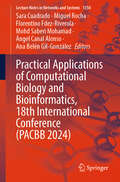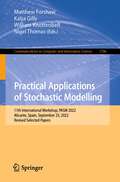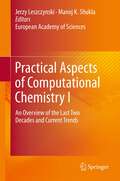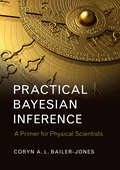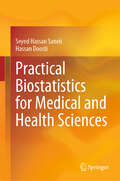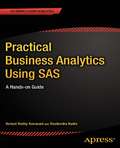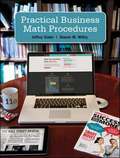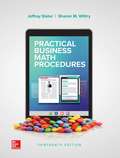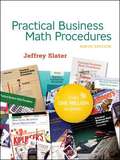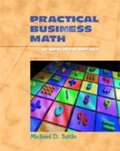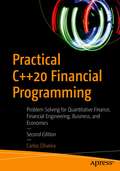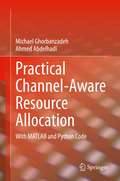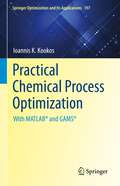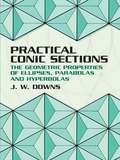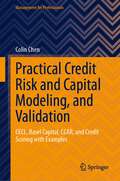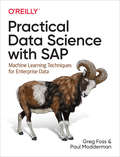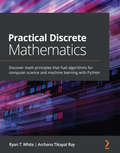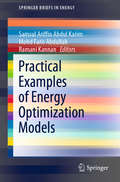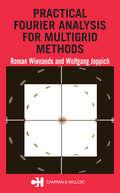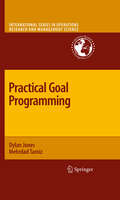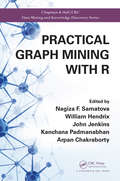- Table View
- List View
Practical Applications of Computational Biology and Bioinformatics, 18th International Conference (Lecture Notes in Networks and Systems #1350)
by Florentino Fdez-Riverola Mohd Saberi Mohamad Miguel Rocha Sara Cuadrado Ana Belén Gil-González Ángel Canal AlonsoThis book aims to promote the interaction among the scientific community to discuss applications of CS/AI with an interdisciplinary character, exploring the interactions between sub-areas of CS/AI, Bioinformatics, Chemoinformatics and Systems Biology. The success of Bioinformatics in recent years has been prompted by research in Molecular Biology and Molecular Medicine in several initiatives. This year’s technical program presents both high quality and diversity, with contributions in well-established and evolving areas of research. The PACBB’24 technical program has selected 22 full papers in the main track and, as in past editions, it will be special issues in ranked journals. This symposium is organized by the BISITE Research Group of the University of Salamanca (Spain). The author would like to thank all the contributing authors, the members of the Program Committee, National Associations (AEPIA, APPIA), and the sponsors (AIR Institute).
Practical Applications of Stochastic Modelling: 11th International Workshop, PASM 2022, Alicante, Spain, September 23, 2022, Revised Selected Papers (Communications in Computer and Information Science #1786)
by Nigel Thomas Matthew Forshaw William Knottenbelt Katja GillyThis book constitutes the referred proceedings of the 11th International Workshop on Practical Applications of Stochastic Modelling, PASM 2022, was held in Alicante, Spain, in September 2022.The 7 full papers presented in this volume were carefully reviewed and selected from 9 submissions. The papers demonstrate a diverse set of applications and approaches of stochastic modelling.
Practical Aspects of Computational Chemistry I: An Overview of the Last Two Decades and Current Trends
by Jerzy Leszczynski Manoj K. K. ShuklaPractical Aspects of Computational Chemistry I: An Overview of the Last Two Decades and Current Trends gathers the advances made within the last 20 years by well-known experts in the area of theoretical and computational chemistry and physics. The title itself reflects the celebration of the twentieth anniversary of the “Conference on Current Trends in Computational Chemistry (CCTCC)” to which all authors have participated and contributed to its success. This volume poses (and answers) important questions of interest to the computational chemistry community and beyond. What is the historical background of the “Structural Chemistry”? Is there any way to avoid the problem of intruder state in the multi-reference formulation? What is the recent progress on multi-reference coupled cluster theory? Starting with a historical account of structural chemistry, the book focuses on the recent advances made in promising theories such as many body Brillouin-Wigner theory, multireference state-specific coupled cluster theory, relativistic effect in chemistry, linear and nonlinear optical properties of molecules, solution to Kohn-Sham problem, electronic structure of solid state materials, development of model core potential, quantum Monte Carlo method, nano and molecular electronics, dynamics of photodimerization and excited states, intermolecular interactions, hydrogen bonding and non-hydrogen bonding interactions, conformational flexibility, metal cations in zeolite catalyst and interaction of nucleic acid bases with minerals. Practical Aspects of Computational Chemistry I: An Overview of the Last Two Decades and Current Trends is aimed at theoretical and computational chemists, physical chemists, materials scientists, and particularly those who are eager to apply computational chemistry methods to problem of chemical and physical importance. This book will provide valuable information to undergraduate, graduate, and PhD students as well as to established researchers.
Practical Aspects of Computational Chemistry II
by Jerzy Leszczynski Manoj ShuklaPractical Aspects of Computational Chemistry II: An Overview of the Last Two Decades and Current Trends gathers the discussion of advances made within the last 20 years by well-known experts in the area of theoretical and computational chemistry and physics. The title reflects the celebration of the twentieth anniversary of the "Conference on Current Trends in Computational Chemistry (CCTCC)" to success of which all authors contributed. Starting with the recent development of modeling of solvation effect using the Polarizable Continuum Model (PCM) at the Coupled-Cluster level and the effects of extreme pressure on the molecular properties within the PCM framework, this volume focuses on the association/dissociation of ion pairs in binary solvent mixtures, application of graph theory to determine the all possible structures and temperature-dependent distribution of water cluster, generalized-ensemble algorithms for the complex molecular simulation, QM/MD based investigation of formation of different nanostructures under nonequilibrium conditions, quantum mechanical study of chemical reactivity of carbon nanotube, covalent functionalization of single walled-carbon nanotube, designing of functional materials, importance of long-range dispersion interaction to study nanomaterials, recent advances in QSPR/QSAR analysis of nitrocompounds, prediction of physico-chemical properties of energetic materials, electronic structure and properties of 3d transition metal dimers, the s-bond activation reactions by transition metal complexes, theoretical modeling of environmental mercury depletion reaction, organolithium chemistry and computational modeling of low-energy electron induced DNA damage. Practical Aspects of Computational Chemistry II: An Overview of the Last Two Decades and Current Trends is aimed at theoretical and computational chemists, physical chemists, materials scientists, and particularly those who are eager to apply computational chemistry methods to problems of chemical and physical importance. This book provides valuable information to undergraduate, graduate, and PhD students as well as to established researchers. Practical Aspects of Computational Chemistry II: An Overview of the Last Two Decades and Current Trends is aimed at theoretical and computational chemists, physical chemists, materials scientists, and particularly those who are eager to apply computational chemistry methods to problems of chemical and physical importance. This book provides valuable information to undergraduate, graduate, and PhD students as well as to established researchers.
Practical Astronomy with your Calculator or Spreadsheet
by Peter Duffett-Smith Jonathan ZwartNow in its fourth edition, this highly regarded book is ideal for those who wish to solve a variety of practical and recreational problems in astronomy using a scientific calculator or spreadsheet. Updated and extended, this new edition shows you how to use spreadsheets to predict, with greater accuracy, solar and lunar eclipses, the positions of the planets, and the times of sunrise and sunset. Suitable for worldwide use, this handbook covers orbits, transformations and general celestial phenomena, and is essential for anyone wanting to make astronomical calculations for themselves. With clear, easy-to-follow instructions for use with a pocket calculator, shown alongside worked examples, it can be enjoyed by anyone interested in astronomy, and will be a useful tool for software writers and students studying introductory astronomy. High-precision spreadsheet methods for greater accuracy are available at www. cambridge. org/practicalastronomy.
Practical Bayesian Inference: A Primer for Physical Scientists.
by Coryn A. L. Bailer-jonesScience is fundamentally about learning from data, and doing so in the presence of uncertainty. This volume is an introduction to the major concepts of probability and statistics, and the computational tools for analysing and interpreting data. It describes the Bayesian approach, and explains how this can be used to fit and compare models in a range of problems. Topics covered include regression, parameter estimation, model assessment, and Monte Carlo methods, as well as widely used classical methods such as regularization and hypothesis testing. The emphasis throughout is on the principles, the unifying probabilistic approach, and showing how the methods can be implemented in practice. R code (with explanations) is included and is available online, so readers can reproduce the plots and results for themselves. Aimed primarily at undergraduate and graduate students, these techniques can be applied to a wide range of data analysis problems beyond the scope of this work. Written in an informal yet precise style, suitable for a wide audience from a range of backgrounds in the physical sciences Promotes the Bayesian approach as a general framework for solving problems, but also makes comparison with frequentist methods Describes how methods can be applied in practice to the readers' own problems, so it is not simply a recipe book The R code from the book is available freely online, allowing readers to see how the theory is actually implemented and reproduce the plots and results in the book
Practical Biostatistics for Medical and Health Sciences
by Seyed Hassan Saneii Hassan DoostiThis book addresses the challenge of presenting biostatistics to medical and health science audiences coherently. Tailored for students and researchers, its 13 chapters progress logically from foundational concepts like measurement scales and statistical calculations to advanced topics such as probability, correlation, regression and health and disease measures. Practical examples enhance relevance, and its gradual approach ensures easy comprehension even for non-statisticians. The book's practical emphasis shines as it culminates in teaching the use of SPSS software for result interpretation, bridging theory and practice effectively. It empowers medical professionals to confidently understand and apply statistical concepts in their work, serving as an indispensable resource in navigating the intricacies of biostatistics in medical and health sciences.
Practical Business Analytics Using SAS
by Venkat Reddy Konasani Shailendra KadrePractical Business Analytics Using SAS: A Hands-on Guide shows SAS users and businesspeople how to analyze data effectively in real-life business scenarios. The book begins with an introduction to analytics, analytical tools, and SAS programming. The authors--both SAS, statistics, analytics, and big data experts--first show how SAS is used in business, and then how to get started programming in SAS by importing data and learning how to manipulate it. Besides illustrating SAS basic functions, you will see how each function can be used to get the information you need to improve business performance. Each chapter offers hands-on exercises drawn from real business situations. The book then provides an overview of statistics, as well as instruction on exploring data, preparing it for analysis, and testing hypotheses. You will learn how to use SAS to perform analytics and model using both basic and advanced techniques like multiple regression, logistic regression, and time series analysis, among other topics. The book concludes with a chapter on analyzing big data. Illustrations from banking and other industries make the principles and methods come to life. Readers will find just enough theory to understand the practical examples and case studies, which cover all industries. Written for a corporate IT and programming audience that wants to upgrade skills or enter the analytics field, this book includes: More than 200 examples and exercises, including code and datasets for practice. Relevant examples for all industries. Case studies that show how to use SAS analytics to identify opportunities, solve complicated problems, and chart a course. Practical Business Analytics Using SAS: A Hands-on Guide gives you the tools you need to gain insight into the data at your fingertips, predict business conditions for better planning, and make excellent decisions. Whether you are in retail, finance, healthcare, manufacturing, government, or any other industry, this book will help your organization increase revenue, drive down costs, improve marketing, and satisfy customers better than ever before.
Practical Business Math Procedures
by Jeffrey Slater Sharon M. WittryKiplinger's Personal Finance is the most trustworthy source of advice and guidance available today on managing your money: how to make and save more of it, invest it profitably, spend it wisely, make it work harder for you, and much more.From our annual economic forecast issue to our ranking of the best mutual funds... from new ways to slash taxes, to the best ways to boost your credit score ... Kiplinger's Personal Finance is devoted to helping you make more money and keep more of the money you make!
Practical Business Math Procedures
by Jeffrey Slater Sharon M. WittryThe Thirteenth Edition of Practical Business Math Procedures provides students with an engaging and personalized way to learn, leading to success in the classroom and beyond. Respected authors Jeffrey Slater and Sharon Wittry incorporate examples from The Wall Street Journal and Kiplinger throughout the entirety of the text to reinforce real-world application of business math. Every chapter concludes with the "My Money" exercises, which encourage students to apply the chapter material to their personal finances while utilizing the Internet’s many resources. <P><P> Connect is the only integrated learning system that empowers students by continuously adapting to deliver precisely what they need, when they need it, and how they need it, so that your class time is more engaging and effective.
Practical Business Math Procedures (9th Edition)
by Jeffrey SlaterThis book uses mathematical techniques to illustrate their application in business aspects.
Practical Business Math: An Applications Approach
by Michael D. TuttleThe eighth edition of Practical Business Math: An Applications Approach continues the successful format of previous editions with an added emphasis on the integrated presentation that makes teaching and learning easier. This emphasis is sure to improve student understanding of business math topics.
Practical C++20 Financial Programming: Problem Solving for Quantitative Finance, Financial Engineering, Business, and Economics
by Carlos OliveiraApply C++ to programming problems in the financial industry using this hands-on book, updated for C++20. It explains those aspects of the language that are more frequently used in writing financial software, including the Standard Template Library (STL), templates, and various numerical libraries. Practical C++20 Financial Programming also describes many of the important problems in financial engineering that are part of the day-to-day work of financial programmers in large investment banks and hedge funds. The author has extensive experience in the New York City financial industry that is now distilled into this handy guide. Focus is on providing working solutions for common programming problems. Examples are plentiful and provide value in the form of ready-to-use solutions that you can immediately apply in your day-to-day work. You’ll see examples of matrix manipulations, curve fitting, histogram generation, numerical integration, and differential equation analysis, and you’ll learn how all these techniques can be applied to some of the most common areas of financial software development. These areas include performance price forecasting, optimizing investment portfolios, and more. The book style is quick and to-the-point, delivering a refreshing view of what one needs to master in order to thrive as a C++ programmer in the financial industry. What You Will Learn Cover aspects of C++ especially relevant to financial programming Write working solutions to commonly encountered problems in finance Design efficient, numerical classes for use in finance, as well as to use those classes provided by Boost and other libraries Who This Book Is For Those who are new to programming for financial applications using C++, but should have some previous experience with C++.
Practical Channel-Aware Resource Allocation: With MATLAB and Python Code
by Ahmed Abdelhadi Michael GhorbanzadehThis book dives into radio resource allocation optimizations, a research area for wireless communications, in a pragmatic way and not only includes wireless channel conditions but also incorporates the channel in a simple and practical fashion via well-understood equations. Most importantly, the book presents a practical perspective by modeling channel conditions using terrain-aware propagation which narrows the gap between purely theoretical work and that of industry methods. The provided propagation modeling reflects industry grade scenarios for radio environment map and hence makes the channel based resource allocation presented in the book a field-grade view. Also, the book provides large scale simulations that account for realistic locations with terrain conditions that can produce realistic scenarios applicable in the field. Most portions of the book are accompanied with MATLAB code and occasionally MATLAB/Python/C code. The book is intended for graduate students, academics, researchers of resource allocation in mathematics, computer science, and electrical engineering departments as well as working professionals/engineers in wireless industry.
Practical Chemical Process Optimization: With MATLAB® and GAMS® (Springer Optimization and Its Applications #197)
by Ioannis K. KookosThis text provides the undergraduate chemical engineering student with the necessary tools for problem solving in chemical or bio-engineering processes. In a friendly, simple, and unified framework, the exposition aptly balances theory and practice. It uses minimal mathematical concepts, terms, algorithms, and describes the main aspects of chemical process optimization using MATLAB and GAMS. Numerous examples and case studies are designed for students to understand basic principles of each optimization method and elicit the immediate discovery of practical applications. Problem sets are directly tied to real-world situations most commonly encountered in chemical engineering applications. Chapters are structured with handy learning summaries, terms and concepts, and problem sets, and individually reinforce the basics of particular optimization methods. Additionally, the wide breadth of topics that may be encountered in courses such as Chemical Process Optimization, Chemical Process Engineering, Optimization of Chemical Processes, are covered in this accessible text. The book provides formal introductions to MATLAB, GAMS, and a revisit to pertinent aspects of undergraduate calculus. While created for coursework, this text is also suitable for independent study. A full solutions manual is available to instructors who adopt the text for their course.
Practical Conic Sections: The Geometric Properties of Ellipses, Parabolas and Hyperbolas (Dover Books on Mathematics)
by J. W. DownsIllustrated with interesting examples from everyday life, this text shows how to create ellipses, parabolas, and hyperbolas and presents fascinating historical background on their ancient origins. The text starts with a discussion of techniques for generating the conic curves, showing how to create accurate depictions of large or small conic curves and describing their reflective properties, from light in telescopes to sound in microphones and amplifiers. It further defines the role of curves in the construction of auditoriums, antennas, lamps, and numerous other design applications. Only a basic knowledge of plane geometry needed; suitable for undergraduate courses. 1993 edition. 98 figures.
Practical Credit Risk and Capital Modeling, and Validation: CECL, Basel Capital, CCAR, and Credit Scoring with Examples (Management for Professionals)
by Colin ChenThis book provides professionals and practitioners with a comprehensive guide on credit risk modeling, capital modeling, and validation for Current Expected Credit Loss (CECL), International Financial Reporting Standard 9 (IFRS9), Basel Capital and Comprehensive Capital Analysis and Review (CCAR) procedures. It describes how credit risk modeling, capital modeling, and validation are done in big banks with code and examples. The book features innovative concepts such as Binary Logit Approximation (BLA) for Competing Risk Framework; Adaptive and Exhaustive Variable Selection (AEVS) for automatic modeling; Full Observation Stratified Sampling (FOSS) for unbiased sampling; and Prohibited Correlation Index (PCI) for Fair Lending Texts. It also features a chapter on credit underwriting and scoring, addressing the credit underwriting risk with some innovations. It is a valuable guide for professionals, practitioners and graduate students in risk management.
Practical Data Analysis - Second Edition
by Hector Cuesta Dr Sampath KumarA practical guide to obtaining, transforming, exploring, and analyzing data using Python, MongoDB, and Apache Spark About This Book * Learn to use various data analysis tools and algorithms to classify, cluster, visualize, simulate, and forecast your data * Apply Machine Learning algorithms to different kinds of data such as social networks, time series, and images * A hands-on guide to understanding the nature of data and how to turn it into insight Who This Book Is For This book is for developers who want to implement data analysis and data-driven algorithms in a practical way. It is also suitable for those without a background in data analysis or data processing. Basic knowledge of Python programming, statistics, and linear algebra is assumed. What You Will Learn * Acquire, format, and visualize your data * Build an image-similarity search engine * Generate meaningful visualizations anyone can understand * Get started with analyzing social network graphs * Find out how to implement sentiment text analysis * Install data analysis tools such as Pandas, MongoDB, and Apache Spark * Get to grips with Apache Spark * Implement machine learning algorithms such as classification or forecasting In Detail Beyond buzzwords like Big Data or Data Science, there are a great opportunities to innovate in many businesses using data analysis to get data-driven products. Data analysis involves asking many questions about data in order to discover insights and generate value for a product or a service. This book explains the basic data algorithms without the theoretical jargon, and you'll get hands-on turning data into insights using machine learning techniques. We will perform data-driven innovation processing for several types of data such as text, Images, social network graphs, documents, and time series, showing you how to implement large data processing with MongoDB and Apache Spark. Style and approach This is a hands-on guide to data analysis and data processing. The concrete examples are explained with simple code and accessible data.
Practical Data Analysis for Designed Experiments (Chapman & Hall/CRC Texts in Statistical Science #39)
by Brian S. YandellPlacing data in the context of the scientific discovery of knowledge through experimentation, Practical Data Analysis for Designed Experiments examines issues of comparing groups and sorting out factor effects and the consequences of imbalance and nesting, then works through more practical applications of the theory. Written in a modern and accessible manner, this book is a useful blend of theory and methods. Exercises included in the text are based on real experiments and real data.
Practical Data Science with SAP: Machine Learning Techniques for Enterprise Data
by Greg Foss Paul ModdermanLearn how to fuse today's data science tools and techniques with your SAP enterprise resource planning (ERP) system. With this practical guide, SAP veterans Greg Foss and Paul Modderman demonstrate how to use several data analysis tools to solve interesting problems with your SAP data.Data engineers and scientists will explore ways to add SAP data to their analysis processes, while SAP business analysts will learn practical methods for answering questions about the business. By focusing on grounded explanations of both SAP processes and data science tools, this book gives data scientists and business analysts powerful methods for discovering deep data truths.You'll explore:Examples of how data analysis can help you solve several SAP challengesNatural language processing for unlocking the secrets in textData science techniques for data clustering and segmentationMethods for detecting anomalies in your SAP dataData visualization techniques for making your data come to life
Practical Discrete Mathematics: Discover math principles that fuel algorithms for computer science and machine learning with Python
by Ryan T. White Archana Tikayat RayA practical guide simplifying discrete math for curious minds and demonstrating its application in solving problems related to software development, computer algorithms, and data scienceKey FeaturesApply the math of countable objects to practical problems in computer scienceExplore modern Python libraries such as scikit-learn, NumPy, and SciPy for performing mathematicsLearn complex statistical and mathematical concepts with the help of hands-on examples and expert guidanceBook DescriptionDiscrete mathematics deals with studying countable, distinct elements, and its principles are widely used in building algorithms for computer science and data science. The knowledge of discrete math concepts will help you understand the algorithms, binary, and general mathematics that sit at the core of data-driven tasks. Practical Discrete Mathematics is a comprehensive introduction for those who are new to the mathematics of countable objects. This book will help you get up to speed with using discrete math principles to take your computer science skills to a more advanced level. As you learn the language of discrete mathematics, you'll also cover methods crucial to studying and describing computer science and machine learning objects and algorithms. The chapters that follow will guide you through how memory and CPUs work. In addition to this, you'll understand how to analyze data for useful patterns, before finally exploring how to apply math concepts in network routing, web searching, and data science. By the end of this book, you'll have a deeper understanding of discrete math and its applications in computer science, and be ready to work on real-world algorithm development and machine learning.What you will learnUnderstand the terminology and methods in discrete math and their usage in algorithms and data problemsUse Boolean algebra in formal logic and elementary control structuresImplement combinatorics to measure computational complexity and manage memory allocationUse random variables, calculate descriptive statistics, and find average-case computational complexitySolve graph problems involved in routing, pathfinding, and graph searches, such as depth-first searchPerform ML tasks such as data visualization, regression, and dimensionality reductionWho this book is forThis book is for computer scientists looking to expand their knowledge of discrete math, the core topic of their field. University students looking to get hands-on with computer science, mathematics, statistics, engineering, or related disciplines will also find this book useful. Basic Python programming skills and knowledge of elementary real-number algebra are required to get started with this book.
Practical Examples of Energy Optimization Models (SpringerBriefs in Energy)
by Ramani Kannan Samsul Ariffin Abdul Karim Mohd Faris AbdullahThis book highlights state-of-the-art research on renewable energy integration technology and suitable and efficient power generation, discussing smart grids, renewable energy grid integration, prediction control models, and econometric models for predicting the global solar radiation and factors that affect solar radiation, performance evaluation of photovoltaic systems, and improved energy consumption prediction models. It discusses several methods, algorithms, environmental data-based performance analyses, and experimental results to help readers gain a detailed understanding of the pros and cons of technologies in this rapidly growing area. Accordingly, it offers a valuable resource for students and researchers working on renewable energy optimization models.
Practical Fourier Analysis for Multigrid Methods (Numerical Insights)
by Roman Wienands Wolfgang JoppichBefore applying multigrid methods to a project, mathematicians, scientists, and engineers need to answer questions related to the quality of convergence, whether a development will pay out, whether multigrid will work for a particular application, and what the numerical properties are. Practical Fourier Analysis for Multigrid Methods uses a detaile
Practical Goal Programming
by Mehrdad Tamiz Dylan JonesPractical Goal Programming is intended to allow academics and practitioners to be able to build effective goal programming models, to detail the current state of the art, and to lay the foundation for its future development and continued application to new and varied fields. Suitable as both a text and reference, its nine chapters first provide a brief history, fundamental definitions, and underlying philosophies, and then detail the goal programming variants and define them algebraically. Chapter 3 details the step-by-step formulation of the basic goal programming model, and Chapter 4 explores more advanced modeling issues and highlights some recently proposed extensions. Chapter 5 then details the solution methodologies of goal programming, concentrating on computerized solution by the Excel Solver and LINGO packages for each of the three main variants, and includes a discussion of the viability of the use of specialized goal programming packages. Chapter 6 discusses the linkages between Pareto Efficiency and goal programming. Chapters 3 to 6 are supported by a set of ten exercises, and an Excel spreadsheet giving the basic solution of each example is available at an accompanying website. Chapter 7 details the current state of the art in terms of the integration of goal programming with other techniques, and the text concludes with two case studies which were chosen to demonstrate the application of goal programming in practice and to illustrate the principles developed in Chapters 1 to 7. Chapter 8 details an application in healthcare, and Chapter 9 describes applications in portfolio selection.
Practical Graph Mining with R (Chapman & Hall/CRC Data Mining and Knowledge Discovery Series)
by John Jenkins Nagiza F. Samatova Arpan Chakraborty William Hendrix Kanchana PadmanabhanDiscover Novel and Insightful Knowledge from Data Represented as a GraphPractical Graph Mining with R presents a "do-it-yourself" approach to extracting interesting patterns from graph data. It covers many basic and advanced techniques for the identification of anomalous or frequently recurring patterns in a graph, the discovery of groups or cluste
